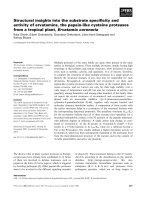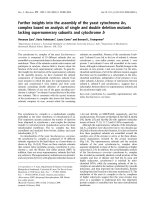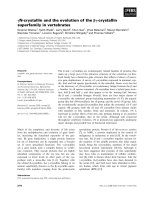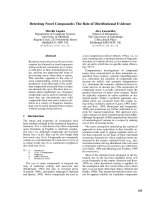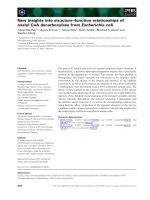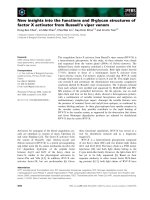báo cáo khoa học: " Recent insights into the role of NF-κB in ovarian carcinogenesis" pot
Bạn đang xem bản rút gọn của tài liệu. Xem và tải ngay bản đầy đủ của tài liệu tại đây (287.81 KB, 3 trang )
Clinical overview of epithelial ovarian cancer
Epithelial ovarian cancer (EOC) accounts for the majority
of ovarian cancer and is the most lethal of all gyneco-
logical malignancies. It was expected that 21,550 new
cases of EOC would be diagnosed in the US in 2009 and
that 14,600 women would die from the disease [1].
Although ovarian cancer accounts for only 3% of all
female cancers, it is the fifth most common cause of
cancer deaths in women. Given that EOC usually pre-
sents with non-specific symptoms, such as bloating or
abdominal discomfort, which can all be mistaken for a
more benign condition, and because there is currently no
means for early detection, patients with EOC are often
diagnosed with late-stage disease (International Federa-
tion of Gynecology and Obstetrics (FIGO) stage III or
IV). On initial diagnosis, patients undergo complete
surgical debulking (resection whose only goal is to make
subsequent therapy more effective) followed by combina-
tion chemotherapy usually consisting of carboplatin and
paclitaxel. Approximately 80% of patients respond to this
treatment regimen, which has been the standard for
more than 10 years [2]. However, 60 to 80% of the res-
pon ders present with recurrent disease between 6 months
and 2 years after treatment. Unfortunately, disease
recurrence is characterized by chemoresistance, resulting
in disease progression and death. As a result, the 5-year
survival rate for patients diagnosed with late-stage
disease is only 15 to 20% [3].
NF-κB in ovarian cancer initiation and progression
Chronic inflammation has been associated with tumor
initiation and progression. In the ovary, carcinogenesis
has been linked to inflammatory processes, such as
repeated ovulation, endometriosis and pelvic infections
[4,5]. e molecular link between inflammation and
cancer is nuclear factor κ light chain enhancer of activated
B cells (NF-κB) [6]. e NF-κB family of proteins, which
has five members (Table1), controls several key processes
that are required for tumor develop ment and progression,
such as: activation of anti-apoptotic genes and genes
involved in the progression of cell cycle [7,8]; secretion of
factors such as tumor necrosis factor (TNF) α and inter-
leukin (IL)-6, which enhances cell growth [6]; promo tion
of a pro-angiogenic environment through enhanced
production of IL-8 and vascular endothelial growth
factor [9]; and creation of a microenvironment that may
prevent immune surveillance [10] (Figure1).
A correlation between NF-κB activation and EOC
clinical profile has been described. Guo et al. [11]
demonstrated that the expression of NF-κB p65 in EOC
tumors is mainly nuclear and that the levels correlate
with poor differentiation and late FIGO stage. Moreover,
they showed that patients who were positive for NF-κB
p65 subunit staining had lower cumulative survival rates
and lower median survival (20% and 24 months, respec-
tively) than patients that were negative (46.2% and
39months, respectively). e correlation between NF-κB
activation status (that is, levels of NF-κB p65 and RelB)
and poor clinical outcome in EOC patients was corro bor-
ated in more recent studies by two other independent
groups [12,13].
In addition to these correlation studies [11-13], the in
vitro activation or specific inhibition of the NF-κB
pathway using either small-molecule inhibitors or short
interfering RNA (siRNA) was recently shown to affect the
growth behavior of EOC cells. Using the ligand TNF-like
weak inducer of apoptosis (TWEAK) to activate NF-κB
Abstract
The NF-κBs are a family of ubiquitously expressed
transcription factors that have been described to be
responsible for the establishment of an inammatory
response. Studies in the past decade have also
demonstrated this family’s role in the initiation and
progression of hematological and solid tumors.
Recently, research has uncovered a specic role for
NF-κBs in the development and maintenance of
ovarian cancer.
© 2010 BioMed Central Ltd
Recent insights into the role of NF-κB in ovarian
carcinogenesis
Ayesha B Alvero*
M INI R E VIE W
*Correspondence:
Department of Obstetrics, Gynecology, and Reproductive Sciences, Yale University
School of Medicine, 333 Cedar St, New Haven, CT 06510, USA
Alvero Genome Medicine 2010, 2:56
/>© 2010 BioMed Central Ltd
in the highly metastatic human EOC cell line HO-
8910PM, Dai et al. [14] showed that although TWEAK-
induced nuclear translocation of NF-κB p65 does not
enhance cell growth, treatment with TWEAK for 6 hours
can significantly enhance adhesion and promote the
migration and invasion capacity of these cells [14]. ese
effects were inhibited when cells were treated with
TWEAK in the presence of the NF-κB inhibitor pyrro-
lidine dithiocarbamate.
In another study, which showed that microRNA-9
(miR-9) could control the levels of NF-κB1, the authors
[15] showed that a decrease in NF-κB1 levels, as a result
of overexpressing miR-9 or by using the siRNA expres-
sion vector pSilencer/si-NF-κB1, is associated with a
reduction in cell growth and colony formation by the
human EOC line ES-2.
In a more recent study using several EOC cell lines,
Hernandez et al. [16] showed that inhibition of the NF-
κB pathway through specific inhibition of inhibitor of
NF-κB kinase β (IKKβ) can decrease the percentage of
viable CAOV3, IGROV1 and A2780 cells. In addition,
they showed that blocking IKKβ activity through either
small-molecule inhibition or siRNA can inhibit
anchorage-independent growth and the capacity of the
cells to invade through a basement membrane. More
importantly, the authors [16] identified the network of
genes controlled by the IKKβ-NF-κB pathway in CAOV3
cells. Using the highly specific IKKβ small-molecule
inhibitor ML120b or IKKβ siRNA to decrease IKKβ
expression, gene expression microarray results showed
that the IKKβ-NF-κB pathway controls genes associated
with EOC cell proliferation, adhesion, invasion,
angiogenesis and the creation of a pro-inflammatory
micro environment.
NF-κB signaling and ovarian cancer stem cells
Our group has identified a subpopulation of EOC cells
that is responsive to the pathway involving Toll-like
receptor 4 (TLR4) and NF-κB [17]. Treatment with the
chemotherapy agent paclitaxel, which is a known TLR4
ligand, induced NF-κB activation, leading to enhanced
cell proliferation. NF-κB is constitutively active in these
cells, resulting in constitutive secretion of pro-inflam-
matory cytokines [17], and this is brought about by
consti tutive IKKβ activity [18]. ese cells also express
the cancer stem cell marker CD44 and are in fact the
ovarian cancer stem cells (OCSCs) [19].
e CD44
+
OCSCs are resistant to chemotherapeutic
agents, and this resistance is partly regulated by the
NF-κB pathway [19]. In our most recent study [20], we
showed that the NF-κB inhibitor Eriocalyxin B can
sensitize these cells to TNFα- and Fas-mediated apop-
tosis. e CD44+ OCSCs can also serve as tumor
vascular progenitors in vitro and in vivo, an effect also
regulated by the NF-κB pathway [21].
Conclusions
Research in the past 5 years has unraveled the multiple
mechanisms that enable NF-κB to support ovarian
carcinogenesis, including that this pathway confers some
of the properties of OCSCs. ese findings highlight the
clinical potential for NF-κB inhibitors to prevent
recurrence and improve survival in EOC patients. e
fact that the main effectors of this pathway significantly
correlate with disease activity suggests the feasibility of
choosing patients that may benefit from targeting this
molecular pathway.
Abbreviations
EOC, epithelial ovarian cancer cells; IKKα, inhibitor of NF-κB kinase α; IKKβ,
inhibitor of NF-κB kinase β; IκB, inhibitor of NFκB; IL, interleukin; NF-κB, Nuclear
factor kappa-light-chain-enhancer of activated B cells; OCSC, ovarian cancer
stem cells; shRNA, short hairpin RNA; siRNA, small interfering RNA; TNFα,
tumor necrosis factor α.
Figure 1. The NF-κB pathway. In unstimulated cells, the NF-κB
subunits p65 and p50 are sequestered in the cytoplasm by IκB.
Ligand binding to receptors (such as TNFα and TLR4) leads to the
activation of the IKK complex, which then phosphorylates IκB.
Phosphorylated IκB is then ubiquitinated and degraded by the
proteasome system, leading to the release of p65 and p50. The
heterodimer then translocates to the nucleus and initiates the
expression of genes that regulate proliferation, cell death, invasion,
migration and immune regulation. This is the canonical pathway;
there is also a non-canonical pathway involving other NF-κB family
members. Most of the studies on EOC have looked at the members
of the canonical pathway.
P
Ligand
Receptor
Cell membrane
NEMO
IKK complex
IκB
IκB
p65
p50
p65
p50
p65
p50
α β
P
Proteasome
Proliferation, chemoresistance,
migration, invasion, immune
regulation
Nuclear membrane
Table 1. Members of the NF-kB family of proteins
Member Other names
NFκB1 NFκB, p105, p50, p50/p105
NFκB2 p52
NFκB3 RelA, p65
RelB
c-Rel
Alvero Genome Medicine 2010, 2:56
/>Page 2 of 3
Competing interests
The author declares that she has no competing interests.
Published: 25 August 2010
References
1. Jemal A, Siegel R, Ward E, Hao Y, Xu J, Thun MJ: Cancer statistics, 2009.
CACancer J Clin 2009, 59:225-249.
2. Covens A, Carey M, Bryson P, Verma S, Fung Kee Fung M, Johnston M:
Systematic review of rst-line chemotherapy for newly diagnosed
postoperative patients with stage II, III, or IV epithelial ovarian cancer.
Gynecol Oncol 2002, 85:71-80.
3. Schwartz PE: Current diagnosis and treatment modalities for ovarian
cancer. Cancer Treat Res 2002, 107:99-118.
4. Cramer DW, Welch WR: Determinants of ovarian cancer risk. II. Inferences
regarding pathogenesis. J Natl Cancer Inst 1983, 71:717-721.
5. Mandai M, Yamaguchi K, Matsumura N, Baba T, Konishi I: Ovarian cancer in
endometriosis: molecular biology, pathology, and clinical management.
Int J Clin Oncol 2009, 14:383-391.
6. Karin M: Nuclear factor-kappaB in cancer development and progression.
Nature 2006, 441:431-436.
7. Karin M, Lin A: NF-kappaB at the crossroads of life and death. Nat Immunol
2002, 3:221-227.
8. Joyce D, Albanese C, Steer J, Fu M, Bouzahzah B, Pestell RG: NF-kappaB and
cell-cycle regulation: the cyclin connection. Cytokine Growth Factor Rev
2001, 12:73-90.
9. Huang S, Robinson JB, Deguzman A, Bucana CD, Fidler IJ: Blockade of
nuclear factor-kappaB signaling inhibits angiogenesis and tumorigenicity
of human ovarian cancer cells by suppressing expression of vascular
endothelial growth factor and interleukin 8. Cancer Res 2000, 60:5334-5339.
10. Karin M, Greten FR: NF-kappaB: linking inammation and immunity to
cancer development and progression. Nat Rev Immunol 2005, 5:749-759.
11. Guo RX, Qiao YH, Zhou Y, Li LX, Shi HR, Chen KS: Increased staining for
phosphorylated AKT and nuclear factor-kappaB p65 and their relationship
with prognosis in epithelial ovarian cancer. Pathol Int 2008, 58:749-756.
12. Annunziata CM, Stavnes HT, Kleinberg L, Berner A, Hernandez LF, Birrer MJ,
Steinberg SM, Davidson B, Kohn EC: Nuclear factor kappaB transcription
factors are coexpressed and convey a poor outcome in ovarian cancer.
Cancer 2010, 116:3276-3284.
13. Darb-Esfahani S, Sinn BV, Weichert W, Budczies J, Lehmann A, Noske A,
Buckendahl AC, Muller BM, Sehouli J, Koensgen D, Gyory B, Dietel M,
Denkert C: Expression of classical NF-kappaB pathway eectors in human
ovarian carcinoma. Histopathology 2010, 56:727-739.
14. Dai L, Gu L, Ding C, Qiu L, Di W: TWEAK promotes ovarian cancer cell
metastasis via NF-kappaB pathway activation and VEGF expression. Cancer
Lett 2009, 283:159-167.
15. Guo LM, Pu Y, Han Z, Liu T, Li YX, Liu M, Li X, Tang H: MicroRNA-9 inhibits
ovarian cancer cell growth through regulation of NF-kappaB1. FEBS J 2009,
276:5537-5546.
16. Hernandez L, Hsu SC, Davidson B, Birrer MJ, Kohn EC, Annunziata CM:
Activation of NF-kappaB signaling by inhibitor of NF-kappaB kinase beta
increases aggressiveness of ovarian cancer. Cancer Res 2010, 70:4005-4014.
17. Kelly MG, Alvero AB, Chen R, Silasi DA, Abrahams VM, Chan S, Visintin I,
Rutherford T, Mor G: TLR-4 signaling promotes tumor growth and
paclitaxel chemoresistance in ovarian cancer. Cancer Res 2006,
66:3859-3868.
18. Chen R, Alvero AB, Silasi DA, Kelly MG, Fest S, Visintin I, Leiser A, Schwartz PE,
Rutherford T, Mor G: Regulation of IKKbeta by miR-199a aects NF-kappaB
activity in ovarian cancer cells. Oncogene 2008, 27:4712-4723.
19. Alvero AB, Chen R, Fu HH, Montagna M, Schwartz PE, Rutherford T, Silasi DA,
Steensen KD, Waldstrom M, Visintin I, Mor G: Molecular phenotyping of
human ovarian cancer stem cells unravels the mechanisms for repair and
chemoresistance. Cell Cycle 2009, 8:158-166.
20. Leiser A, Alvero AB, Fu H, Holmberg J, Cheng YC, Silasi D, Rutherford, R, Mor G:
Regulation of inammation by the NFκB pathway in the ovarian cancer
stem cells. Am J Reprod Immunol 2010, in press.
21. Alvero AB, Fu HH, Holmberg J, Visintin I, Mor L, Marquina CC, Oidtman J, Silasi
DA, Mor G: Stem-like ovarian cancer cells can serve as tumor vascular
progenitors. Stem Cells 2009, 27:2405-2413.
doi:10.1186/gm177
Cite this article as: Alvero AB: Recent insights into the role of NF-κB in
ovarian carcinogenesis. Genome Medicine 2010, 2:56.
Alvero Genome Medicine 2010, 2:56
/>Page 3 of 3

